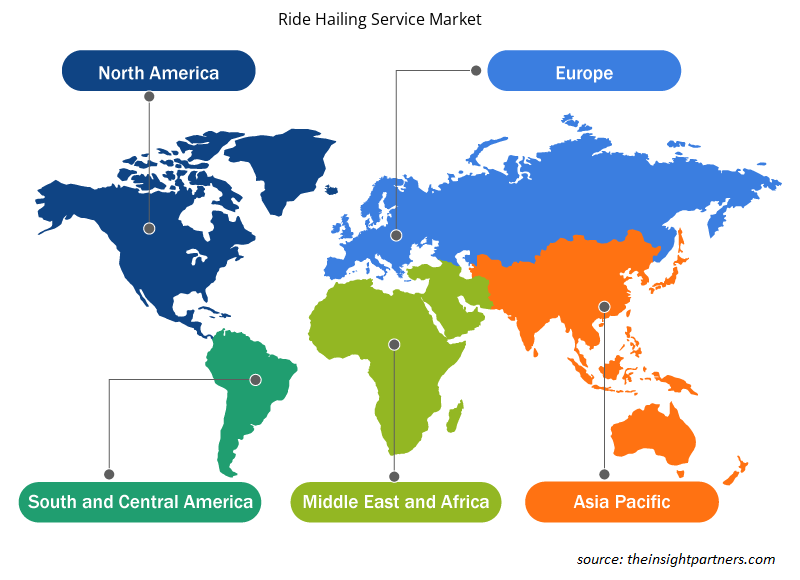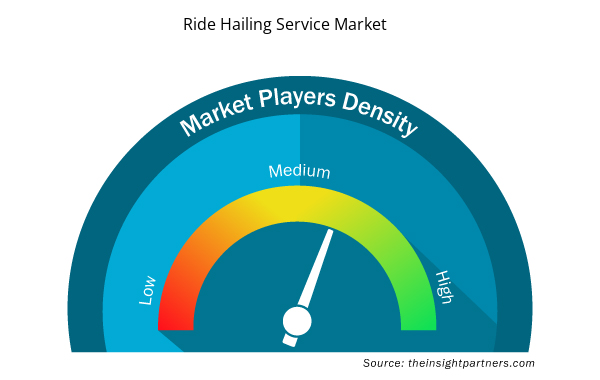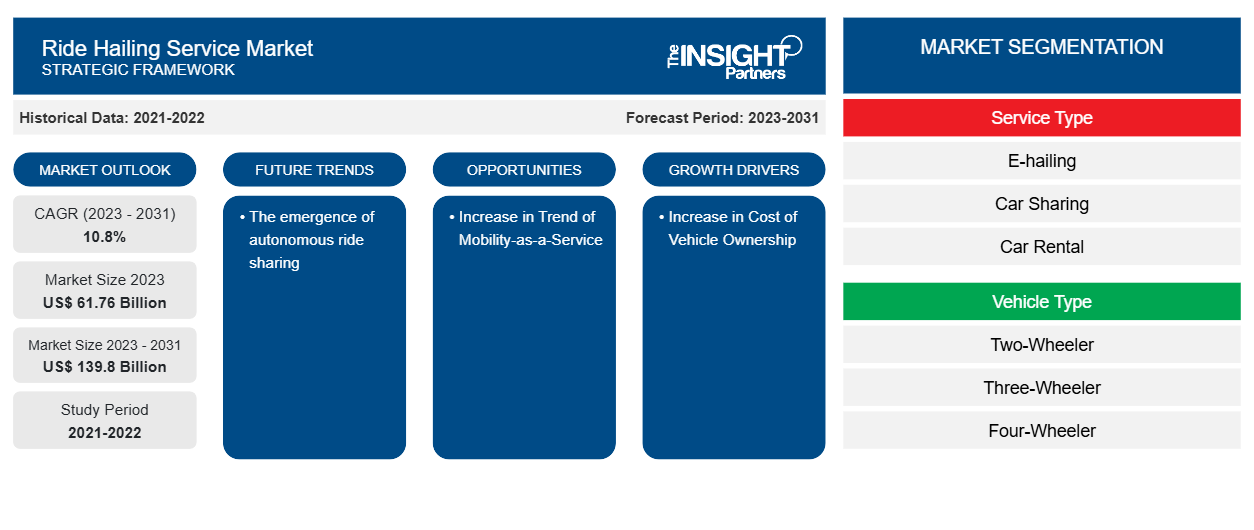من المتوقع أن يصل حجم سوق خدمات النقل بالسيارات إلى 139.8 مليار دولار أمريكي بحلول عام 2031 من 61.76 مليار دولار أمريكي في عام 2023. ومن المتوقع أن يسجل السوق معدل نمو سنوي مركب بنسبة 10.8٪ خلال الفترة 2023-2031. ومن المرجح أن يظل ظهور خدمة مشاركة الرحلات ذاتية القيادة اتجاهًا رئيسيًا في السوق.
تحليل سوق خدمات النقل التشاركي
من المتوقع أن يؤدي ارتفاع اتجاه خدمات النقل حسب الطلب في جميع أنحاء العالم إلى دفع نمو السوق في السنوات القادمة. بالإضافة إلى ذلك، من المتوقع أن يؤدي ارتفاع تكلفة امتلاك المركبات إلى زيادة الطلب على خدمات نقل الركاب خلال فترة التوقعات. علاوة على ذلك، من المتوقع أن يؤدي ارتفاع اتجاه التنقل كخدمة في جميع أنحاء العالم إلى دفع نمو سوق خدمات نقل الركاب من عام 2023 إلى عام 2031.
نظرة عامة على سوق خدمات النقل التشاركي
تشمل الجهات المعنية الرئيسية في منظومة سوق خدمات النقل بالسيارات مقدمي حلول التكنولوجيا ومقدمي خدمات النقل بالسيارات والمستخدمين النهائيين. يشمل مقدمو حلول التكنولوجيا الأجهزة المتصلة أو غيرها من الشركات المصنعة للأجهزة ومطوري البرامج. إن الزيادة في عدد مقدمي حلول التكنولوجيا تدفع بشكل حاسم إلى التحول الرقمي في خدمات النقل بالسيارات. ومن المتوقع أن تزيد خدمات النقل بالسيارات بعد كوفيد بسبب الاتجاه المتزايد لخدمات النقل عند الطلب، وخلق فرص العمل، وانخفاض معدل ملكية السيارات بين جيل الألفية. بالإضافة إلى ذلك، فإن التقدم التكنولوجي في المركبات المتصلة والأوتوماتيكية للحد من انبعاثات ثاني أكسيد الكربون والزيادات الكبيرة في مبيعات هذه المركبات الذكية والفعالة لاستخدام خدمات النقل بالسيارات تدفع نمو السوق العالمية. يأخذ مقدمو خدمات النقل بالسيارات الخدمات من مقدمي حلول التكنولوجيا. مع التطورات التكنولوجية المتزايدة في خدمات النقل بالسيارات، يتزايد الطلب على سوق خدمات النقل بالسيارات.
قم بتخصيص هذا التقرير ليناسب متطلباتك
ستحصل على تخصيص لأي تقرير - مجانًا - بما في ذلك أجزاء من هذا التقرير، أو تحليل على مستوى الدولة، وحزمة بيانات Excel، بالإضافة إلى الاستفادة من العروض والخصومات الرائعة للشركات الناشئة والجامعات
- احصل على أهم اتجاهات السوق الرئيسية لهذا التقرير.ستتضمن هذه العينة المجانية تحليلاً للبيانات، بدءًا من اتجاهات السوق وحتى التقديرات والتوقعات.
محركات وفرص سوق خدمات النقل التشاركي
ارتفاع تكلفة امتلاك المركبات لصالح السوق
تساهم التمويل والوقود والصيانة والتسجيل/الضرائب والصيانة، فضلاً عن الاستهلاك، في تكلفة امتلاك السيارة. تزداد تكلفة امتلاك السيارة عامًا بعد عام. ويمثل الاستهلاك أكثر من 43٪ من إجمالي تكلفة الملكية، وفقًا لجمعية السيارات الأمريكية (AAA). ومع ذلك، فإن التكاليف الأخرى، مثل الصيانة والبنزين ، تمثل 25٪. زادت أسعار الوقود وتكاليف الصيانة بشكل كبير في السنوات العشر الماضية ومن المتوقع أن تزيد في السنوات القادمة. وعلى الرغم من زيادة ملكية السيارات أثناء الوباء، فمن المتوقع أن تنخفض بعد عام 2021 وتعود إلى مستويات ما قبل الوباء. وهذا يسمح لمقدمي خدمات نقل الركاب بالاستفادة من هذا التطور الديموغرافي، حيث يعد الجيل الجديد المتمرس في التكنولوجيا من بين المستخدمين الأكثر نشاطًا لهذه الخدمات.pre-pandemic levels. This allows ride-hailing providers to benefit from this demographic development, as the new technology-savvy generation is among the most active users of these services.
زيادة في اتجاه التنقل كخدمة
يمكن للعملاء غير القادرين على شراء السيارة تجربة سفر سلس من خلال خدمات التنقل. تعمل خدمة التنقل كخدمة على تقليل تكلفة التملك والتشغيل من خلال تعظيم تكلفة مشاركة السيارات وطلب الركوب. بالإضافة إلى ذلك، فإن الوتيرة السريعة للتحضر تؤدي بالفعل إلى ازدحام مروري. قد يكون مفهوم خدمة التنقل (MaaS) خيارًا أفضل لتقليل الازدحام المروري من خلال الاستخدام الأكبر لشبكة النقل العام والخاص الحالية. الطلب العاجل والمتزايد على حلول فعالة للتعامل مع حركة المرور في المدن الذكية والذي بدوره من المتوقع أن يغذي نمو سوق خدمة طلب الركوب حتى عام 2031. لذلك، من المتوقع أن يؤدي الاتجاه المتزايد للتنقل كخدمة (MaaS) إلى تغذية نمو سوق خدمة طلب الركوب العالمية.MaaS) concept may be a better choice for minimizing traffic congestion by greater use of existing public and private transportation network. The urgent and increased demand for effective solutions to handle traffic in smart cities which in turn is expected to fuel ride hailing service market growth through 2031. Therefore, the increasing trend of mobility as a Service (MaaS) is expected to fuel the growth of the global ride-hailing service market.
تقرير تحليلي لتجزئة سوق خدمات النقل التشاركي
القطاعات الرئيسية التي ساهمت في استنباط تحليل سوق خدمات النقل التشاركي هي نوع الخدمة، ونوع السيارة، والموقع، والمستخدم النهائي
- بناءً على نوع الخدمة، ينقسم سوق خدمات النقل بالسيارات إلى خدمات النقل الإلكتروني ومشاركة السيارات وتأجير السيارات والتنقل عبر المحطات. وقد احتل قطاع النقل بالسيارات الإلكتروني أكبر حصة سوقية في عام 2023.
- بحسب نوع المركبة، يتم تقسيم السوق إلى مركبات ذات عجلتين، ومركبات ذات ثلاث عجلات، ومركبات ذات أربع عجلات، وغيرها. وقد استحوذت فئة المركبات ذات الأربع عجلات على أكبر حصة من السوق في عام 2023.
- على أساس الموقع، ينقسم السوق إلى حضري وريفي. وقد استحوذ القطاع الحضري على حصة كبيرة من السوق في عام 2023.
- بحسب المستخدم النهائي، يتم تقسيم السوق إلى مؤسسي وشخصي. احتل القطاع المؤسسي الحصة الأكبر من السوق في عام 2023.
تحليل حصة سوق خدمات النقل التشاركي حسب المنطقة الجغرافية
ينقسم النطاق الجغرافي لتقرير سوق خدمات نقل الركاب بشكل أساسي إلى خمس مناطق: أمريكا الشمالية، وآسيا والمحيط الهادئ، وأوروبا، والشرق الأوسط وأفريقيا، وأمريكا الجنوبية.
يشمل نطاق تقرير سوق خدمات نقل الركاب أمريكا الشمالية (الولايات المتحدة وكندا والمكسيك) وأوروبا (ألمانيا وفرنسا وإيطاليا وإسبانيا والمملكة المتحدة وبقية أوروبا) وآسيا والمحيط الهادئ (الصين والهند وأستراليا واليابان وكوريا الجنوبية وبقية آسيا والمحيط الهادئ) والشرق الأوسط وأفريقيا (جنوب أفريقيا والمملكة العربية السعودية والإمارات العربية المتحدة وبقية الشرق الأوسط وأفريقيا) وأمريكا الجنوبية (البرازيل والأرجنتين وبقية أمريكا الجنوبية). من حيث الإيرادات، سيطرت منطقة آسيا والمحيط الهادئ على حصة سوق خدمات نقل الركاب في عام 2023. كانت أمريكا الشمالية ثاني أكبر مساهم في الإيرادات في سوق خدمات نقل الركاب العالمية، تليها أوروبا.
نظرة إقليمية على سوق خدمات النقل التشاركي
لقد قام المحللون في Insight Partners بشرح الاتجاهات والعوامل الإقليمية المؤثرة على سوق خدمات النقل عبر الإنترنت طوال فترة التوقعات بشكل شامل. يناقش هذا القسم أيضًا قطاعات سوق خدمات النقل عبر الإنترنت والجغرافيا في جميع أنحاء أمريكا الشمالية وأوروبا ومنطقة آسيا والمحيط الهادئ والشرق الأوسط وأفريقيا وأمريكا الجنوبية والوسطى.

- احصل على البيانات الإقليمية المحددة لسوق خدمات النقل التشاركي
نطاق تقرير سوق خدمات النقل التشاركي
| سمة التقرير | تفاصيل |
|---|---|
| حجم السوق في عام 2023 | 61.76 مليار دولار أمريكي |
| حجم السوق بحلول عام 2031 | 139.8 مليار دولار أمريكي |
| معدل النمو السنوي المركب العالمي (2023 - 2031) | 10.8% |
| البيانات التاريخية | 2021-2022 |
| فترة التنبؤ | 2023-2031 |
| القطاعات المغطاة | حسب نوع الخدمة
|
| المناطق والدول المغطاة | أمريكا الشمالية
|
| قادة السوق وملفات تعريف الشركات الرئيسية |
|
كثافة اللاعبين في سوق خدمات النقل التشاركي: فهم تأثيرها على ديناميكيات الأعمال
يشهد سوق خدمات النقل الجماعي نموًا سريعًا، مدفوعًا بالطلب المتزايد من جانب المستخدم النهائي بسبب عوامل مثل تفضيلات المستهلكين المتطورة والتقدم التكنولوجي والوعي المتزايد بفوائد المنتج. ومع ارتفاع الطلب، تعمل الشركات على توسيع عروضها والابتكار لتلبية احتياجات المستهلكين والاستفادة من الاتجاهات الناشئة، مما يؤدي إلى زيادة نمو السوق.
تشير كثافة اللاعبين في السوق إلى توزيع الشركات أو المؤسسات العاملة في سوق أو صناعة معينة. وهي تشير إلى عدد المنافسين (اللاعبين في السوق) الموجودين في مساحة سوق معينة نسبة إلى حجمها أو قيمتها السوقية الإجمالية.
الشركات الرئيسية العاملة في سوق خدمات النقل التشاركي هي:
- شركة أني تكنولوجيز الخاصة المحدودة
- شركة دايملر ايه جي
- شركة دلفي للتكنولوجيا
- شركة ديدي العالمية
- جيت
- شركة جراب القابضة المحدودة
إخلاء المسؤولية : الشركات المذكورة أعلاه ليست مرتبة بأي ترتيب معين.

- احصل على نظرة عامة على أهم اللاعبين الرئيسيين في سوق خدمات النقل
أخبار سوق خدمات النقل التشاركي والتطورات الأخيرة
يتم تقييم سوق خدمات النقل بالسيارات من خلال جمع البيانات النوعية والكمية بعد البحث الأولي والثانوي، والتي تتضمن منشورات الشركات المهمة وبيانات الجمعيات وقواعد البيانات. فيما يلي بعض التطورات في سوق خدمات النقل بالسيارات:
- قامت شركة Kakao Mobility، وهي شركة تقدم خدمات النقل التشاركي، بتوسيع حضورها من خلال إطلاق خدمات النقل التشاركي في آسيا والشرق الأوسط. (المصدر: Kakao Mobility، بيان صحفي، نوفمبر 2023)
- بدأت شركة DiDi Global Inc. عملية تسجيل السائقين في مدينة كيب تاون بجنوب أفريقيا، وبدأت في تقديم خدمات النقل التشاركي للمستهلكين في ثاني أكبر مدينة في البلاد. (المصدر: DiDi Global Inc.، بيان صحفي، مارس 2021)
تقرير سوق خدمات النقل التشاركي: التغطية والنتائج المتوقعة
يوفر تقرير "حجم سوق خدمات النقل التشاركي والتوقعات (2021-2031)" تحليلاً مفصلاً للسوق يغطي المجالات التالية:
- حجم سوق خدمات النقل التشاركي وتوقعاته على المستويات العالمية والإقليمية والوطنية لجميع قطاعات السوق الرئيسية التي يغطيها النطاق
- اتجاهات سوق خدمات النقل التشاركي بالإضافة إلى ديناميكيات السوق مثل السائقين والقيود والفرص الرئيسية
- تحليل مفصل لـ PEST و SWOT
- تحليل سوق خدمات النقل التشاركي الذي يغطي اتجاهات السوق الرئيسية والإطار العالمي والإقليمي والجهات الفاعلة الرئيسية واللوائح والتطورات الأخيرة في السوق
- تحليل المشهد الصناعي والمنافسة الذي يغطي تركيز السوق، وتحليل خريطة الحرارة، واللاعبين البارزين، والتطورات الأخيرة لسوق خدمة نقل الركاب
- ملفات تعريف الشركة التفصيلية
- التحليل التاريخي (سنتان)، السنة الأساسية، التوقعات (7 سنوات) مع معدل النمو السنوي المركب
- تحليل PEST و SWOT
- حجم السوق والقيمة / الحجم - عالميًا وإقليميًا وقطريًا
- الصناعة والمنافسة
- مجموعة بيانات Excel



Report Coverage
Revenue forecast, Company Analysis, Industry landscape, Growth factors, and Trends

Segment Covered
This text is related
to segments covered.

Regional Scope
North America, Europe, Asia Pacific, Middle East & Africa, South & Central America

Country Scope
This text is related
to country scope.
الأسئلة الشائعة
Asia Pacific dominated the ride hailing service market in 2023.
The emergence of autonomous ride-sharing is the future trend of the ride hailing service market
ANI Technologies Private Limited, Daimler AG, Delphi Technologies PLC, DiDi Global Inc., Gett, Grab Holdings Inc., Lyft, Inc., TUKTUK RIDE, Uber Technologies Inc., and zTrip are some of the leading players in the ride hailing service market.
US$ 139.8 billion estimated value of the ride hailing service market by 2031.
10.8% is the expected CAGR of the ride hailing service market.
Trends and growth analysis reports related to Automotive and Transportation : READ MORE..
The Insight Partners performs research in 4 major stages: Data Collection & Secondary Research, Primary Research, Data Analysis and Data Triangulation & Final Review.
- Data Collection and Secondary Research:
As a market research and consulting firm operating from a decade, we have published and advised several client across the globe. First step for any study will start with an assessment of currently available data and insights from existing reports. Further, historical and current market information is collected from Investor Presentations, Annual Reports, SEC Filings, etc., and other information related to company’s performance and market positioning are gathered from Paid Databases (Factiva, Hoovers, and Reuters) and various other publications available in public domain.
Several associations trade associates, technical forums, institutes, societies and organization are accessed to gain technical as well as market related insights through their publications such as research papers, blogs and press releases related to the studies are referred to get cues about the market. Further, white papers, journals, magazines, and other news articles published in last 3 years are scrutinized and analyzed to understand the current market trends.
- Primary Research:
The primarily interview analysis comprise of data obtained from industry participants interview and answers to survey questions gathered by in-house primary team.
For primary research, interviews are conducted with industry experts/CEOs/Marketing Managers/VPs/Subject Matter Experts from both demand and supply side to get a 360-degree view of the market. The primary team conducts several interviews based on the complexity of the markets to understand the various market trends and dynamics which makes research more credible and precise.
A typical research interview fulfils the following functions:
- Provides first-hand information on the market size, market trends, growth trends, competitive landscape, and outlook
- Validates and strengthens in-house secondary research findings
- Develops the analysis team’s expertise and market understanding
Primary research involves email interactions and telephone interviews for each market, category, segment, and sub-segment across geographies. The participants who typically take part in such a process include, but are not limited to:
- Industry participants: VPs, business development managers, market intelligence managers and national sales managers
- Outside experts: Valuation experts, research analysts and key opinion leaders specializing in the electronics and semiconductor industry.
Below is the breakup of our primary respondents by company, designation, and region:

Once we receive the confirmation from primary research sources or primary respondents, we finalize the base year market estimation and forecast the data as per the macroeconomic and microeconomic factors assessed during data collection.
- Data Analysis:
Once data is validated through both secondary as well as primary respondents, we finalize the market estimations by hypothesis formulation and factor analysis at regional and country level.
- Macro-Economic Factor Analysis:
We analyse macroeconomic indicators such the gross domestic product (GDP), increase in the demand for goods and services across industries, technological advancement, regional economic growth, governmental policies, the influence of COVID-19, PEST analysis, and other aspects. This analysis aids in setting benchmarks for various nations/regions and approximating market splits. Additionally, the general trend of the aforementioned components aid in determining the market's development possibilities.
- Country Level Data:
Various factors that are especially aligned to the country are taken into account to determine the market size for a certain area and country, including the presence of vendors, such as headquarters and offices, the country's GDP, demand patterns, and industry growth. To comprehend the market dynamics for the nation, a number of growth variables, inhibitors, application areas, and current market trends are researched. The aforementioned elements aid in determining the country's overall market's growth potential.
- Company Profile:
The “Table of Contents” is formulated by listing and analyzing more than 25 - 30 companies operating in the market ecosystem across geographies. However, we profile only 10 companies as a standard practice in our syndicate reports. These 10 companies comprise leading, emerging, and regional players. Nonetheless, our analysis is not restricted to the 10 listed companies, we also analyze other companies present in the market to develop a holistic view and understand the prevailing trends. The “Company Profiles” section in the report covers key facts, business description, products & services, financial information, SWOT analysis, and key developments. The financial information presented is extracted from the annual reports and official documents of the publicly listed companies. Upon collecting the information for the sections of respective companies, we verify them via various primary sources and then compile the data in respective company profiles. The company level information helps us in deriving the base number as well as in forecasting the market size.
- Developing Base Number:
Aggregation of sales statistics (2020-2022) and macro-economic factor, and other secondary and primary research insights are utilized to arrive at base number and related market shares for 2022. The data gaps are identified in this step and relevant market data is analyzed, collected from paid primary interviews or databases. On finalizing the base year market size, forecasts are developed on the basis of macro-economic, industry and market growth factors and company level analysis.
- Data Triangulation and Final Review:
The market findings and base year market size calculations are validated from supply as well as demand side. Demand side validations are based on macro-economic factor analysis and benchmarks for respective regions and countries. In case of supply side validations, revenues of major companies are estimated (in case not available) based on industry benchmark, approximate number of employees, product portfolio, and primary interviews revenues are gathered. Further revenue from target product/service segment is assessed to avoid overshooting of market statistics. In case of heavy deviations between supply and demand side values, all thes steps are repeated to achieve synchronization.
We follow an iterative model, wherein we share our research findings with Subject Matter Experts (SME’s) and Key Opinion Leaders (KOLs) until consensus view of the market is not formulated – this model negates any drastic deviation in the opinions of experts. Only validated and universally acceptable research findings are quoted in our reports.
We have important check points that we use to validate our research findings – which we call – data triangulation, where we validate the information, we generate from secondary sources with primary interviews and then we re-validate with our internal data bases and Subject matter experts. This comprehensive model enables us to deliver high quality, reliable data in shortest possible time.


 احصل على عينة مجانية لهذا التقرير
احصل على عينة مجانية لهذا التقرير